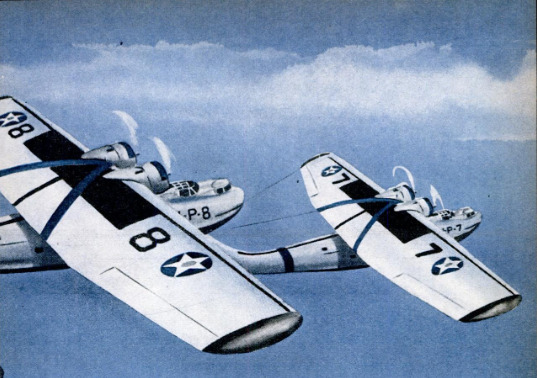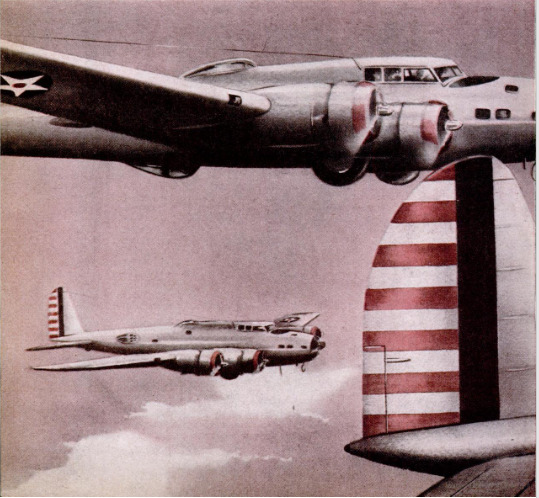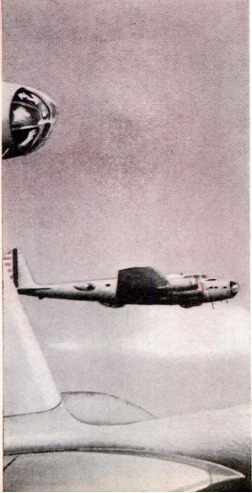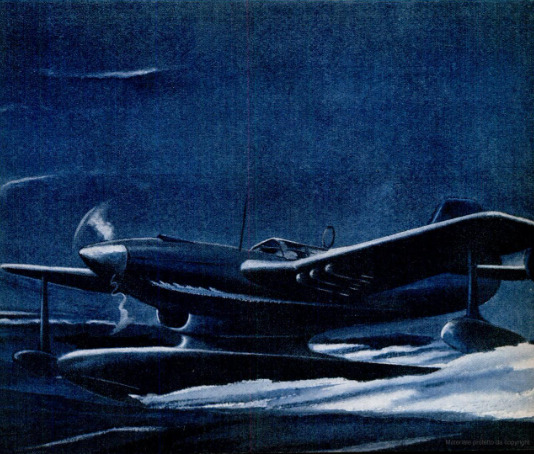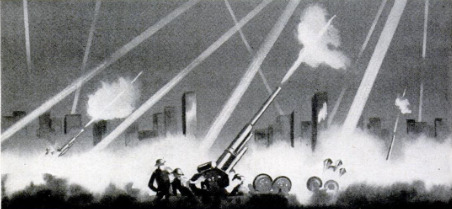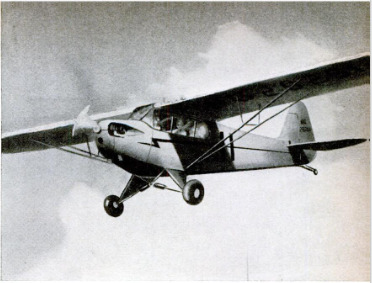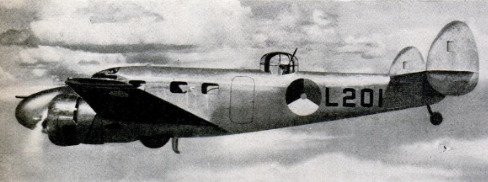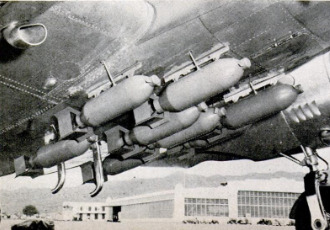-
Title (Dublin Core)
-
Air defense -1941 style
-
Article Title and/or Image Caption (Dublin Core)
-
Title: Air defense -1941 style
-
extracted text (Extract Text)
-
Those of our citizens who are having the
jitters about possible mass bombings of
American cities from the air, or who fear
outright invasion, should take a sedative
and survey the situation from the stand-
point of those who are to do the bombing
or invading. We cannot be attacked by tele-
vision, fortunately. We can be attacked
only by an enemy who possesses the physi-
cal means to span several thousand miles of
ocean and carry out his design. How is he
going to do it?
He cannot fly over from Asia or Europe
directly. For the present, there are no mili-
tary planes, in numbers worth considering,
capable of crossing, dropping bombs, and
returning home. That sort of thing is on an
experimental basis, as yet. Some of the
experts assure us that such bombers will
be an aeronautical commonplace in five
years, perhaps less. If they are right, our
air-defense problem will become far more
difficult in the future. But we have time to
get ready for that situation. As an imme-
diate possibility it is out.
This reduces the means of direct attack
to surface ships and airplanes operating
from surface ships, and brings the United
States Navy into the picture. The Navy is
prepared for any immediate eventuality.
Early this year a clear-headed American
army officer wrote in one of the technical
military journals, “The Navy is always
ready for war, the Army never.” That is
true in the air as well as on land and at sea.
It is no particular credit to the Navy, and
reflects no discredit whatsoever on the
Army. It simply expresses the fact that for
a country situated between two oceans, the
Navy is necessarily the first line of defense.
It was planned that way and the principle
remains sound.
Most Americans know that the Navy has
a first-rate air arm—the newsreels tell them
that much—but very few know that our
naval air force is not only one of the best,
but the largest in the world. The totalita-
rian brethren know it, though, even if our
citizens don't. This naval air force, even
without the support of the Army's heavy
bombers, could make the high seas very
unhealthy for any foreign expeditionary
force which ventured thousands of miles
from home to attack the continental United
States. Perhaps our patrol bombers and
flying fortresses can't send capital ships
with heavy deck armor to the bottom, but
they can certainly send them into dry dock,
back where they came from. The invaders,
as long as bombers are confined to their
present ranges, will not have the where-
withal to inflict the same punishment on
our ships.
Aircraft carriers? Yes, but an aircraft
carrier does not transport many heavy
bombers, and is itself in danger of being
sunk by a single large land-based plane, or
a seaplane operating from a tender. Nobody
has very many carriers, and a navy is about
as willing to risk them in enemy waters as
—well, as the British were in the Norwegian |
campaign, and that was only across the |
North Sea. We have seven carriers our-
selves, two of them old but modernized, one
six years old, the rest new or practically |
new, and their 500-odd planes can keep a
sharp eye on a lot of ocean and do some
light and medium bombing on the side.
Indirect attack offers better possibilities
for sustained air assault on American ob-
jectives—the only kind which has military |
significance. This would entail the estab-
lishment of an air base or bases in the |
Western Hemisphere from which large
numbers of bombers could take off for the
Panama Canal and the United States.
Granting that all the ships the totalitarians
could detach, plus a good part of the British |
fleet if it fell into German hands, would still |
be incompetent to challenge the American
Fleet in its home waters, such an armada |
might make a landing in South America,
which is not home waters for us either. But |
the venture is not one to be gone into |
lightly. A foreign expeditionary force can-
not be sneaked across to the Americas.
Three divisions, about 50,000 men, would
require almost 400,000 tons of shipping be-
sides the escorting force. And that would
be only a beginning. Once the army was
landed, a minimum of 700,000 tons of ship- |
ping would be required monthly just to sup-
ply them, and they would have to be sup-
plied very well to carry on their aerial op-
erations to the north. Nor would they be
unmolested during the preparatory period, |
for where Pan-American airliners go, long-
range bombers can go likewise. |
But let the worst come to the worst: |
assume that the Canal is blocked before the |
third set of locks can be installed, and that
with the bulk of the Fleet isolated in one |
ocean, the other coast must rely entirely on
its shore batteries, antiaircraft artillery,
and aviation. The theory of cobrdinated
naval-and-air defense for America would
then rest more than ever on the massive
use of the bomber against invaders by sea
and air. And if all this happened before the
end of 1941, while we were still short of
bombers for such an extremity, what then?
A suggestion that is frequently made in
this connection is the conversion of com-
mercial planes into bombers. The United
States leads the world in commercial air
transport, and our factories are equipped to
manufacture bombers of the same basic
design, carrying T.N.T. instead of passen-
gers. In some quarters it is asserted that,
stripped and souped up, such improvised
bombers could fly 300 m.p.h. at 20,000 feet,
and their operating radii would be 1,500
miles with 1.5 tons of bombs, or 1,000 miles
with two tons. Service flyers differ with
these estimates and point out that combat
aircraft should be originally designed and
built to withstand stresses and loads which
are not encountered in commercial flying.
“You can't merely hang a bomb rack and a
load of bombs on a DC-3 transport and have
a military bomber,” as one prominent naval
aviation officer puts it.
To a detached observer it looks as if both
sides were right and that they are talking
of different situations. Army and navy men
nowadays are technicians, and they take a
technician's pride in machines—their ma-
chines. Without such a feeling they would
be no good as technicians or fighters. More-
over, the officers who do the planning want
to be assured that the planes in which other
men are to do the flying are the best ma-
chines that engineering can produce and
money can buy. That also needs no justifi-
cation. But in an emergency such consid-
erations must go by the board. In that case
a few hundred or even a few thousand us-
able if by no means perfect bombers might
be a sample of Yankee practicality on the
order of the Nazis’ feat in pouring out
planes with short-lived engines and a mini-
mum of instruments—planes that were far
from a technician's dream, but that were
ready when the Nazis needed them.
There may be no emergency of this kind.
At the moment it seems remote. But while
the drafting and tooling for the de luxe
bombers is going ahead, the conversion idea
should be put to the test—just in case.
It cannot be too strongly emphasized that
the long-range bomber, coordinated with
naval operations, is the key to American
air defense. We have on hand about 1,500
army and navy bombers, roughly half of
which are in the medium and heavy class.
We shall have more of them long before we
can build our two-ocean Navy, long before
we can train a large Army. With an ade-
quate fleet of bombers we are in the posi-
tion of a prize fighter with a long reach and
great skill in boxing, matched against a
strong, stocky opponent who likes to clinch
and fight to the stomach. Why let him get
closer than we can help? The results of let-
ting him bore in are plain enough from
England's experience. If one must rely on
pursuit and antiaircraft guns to ward off
the bombers over the streets, one may fight
with superhuman courage—but the streets
will still be full of wreckage afterwards.
Against invading air fleets this is protection
which does not protect, and which can at
best win a stalemate, not a victory. The
comparison is even more to the point when
it comes to land operations. If we take ad-
vantage of the breaks which Providence
has given us on the sea and in the air over
the sea, we shall never have to use our
Army to resist invasion by actual fighting
on the ground. Its value in that respect will
be purely psychological and diplomatic.
But in the air the Army's role is almost
as important as the Navy's. Army bombers
can fly over the ocean just as well as sea-
planes, and although the latter have the
advantage of operating from any point
where sheltered water and a tender are
available, the Army can in many cases per-
form long-range bombing missions with
equal efficiency. The Army also has the
enormously important responsibility of de-
fending the Navy's vital bases—in effect,
the Navy protects the country and the
Army protects the Navy at fixed points.
Far-flung bases are vital to the long-range
defense plan, and everything depends on
ability to hold strategic areas like Hawaii,
Puerto Rico, and Panama.
This is a big country, and the Army and
Navy together cannot guarantee 100-per-
cent security. There is no such insurance
in war. If we get into the war our coastal
cities may be subjected to occasional hit-
and-run bombing raids. One or more small
or medium planes might be released from
a merchant vessel acting as a tender or
carrier, or even from a large submarine.
On a larger scale, an airplane carrier might
be sneaked to within a few hundred miles
of the coast; its planes could be released to
bomb cities at dusk, returning to the carrier
in darkness so as not to betray its position,
or the whole operation might be carried out
after nightfall. It would have little military
importance, but it would have scare value;
and that would be the object.
Such raids are difficult to cope with until
the mother ship is located and destroyed or
chased away. At least on the first attempt,
it is likely that bombs could be dropped.
After that an air patrol might intercept
the attackers during the daytime. At night,
however, pursuit defense is not very depend-
able. As bomber speeds rise pursuit from
the ground is at an increasing disadvantage,
even by day. With the bomber only 50
m.p.h. slower than the interceptor, an alert
factor of 15 minutes requires a 200-mile
warning if the defending plane is to meet
the attacker in front of the objective; even
with the best pursuit speeds and a shorter
alert factor, a 100-mile warning is the least
that will do. One cannot depend on getting
even a 100-mile warning from the sea.
Under these conditions the importance of
antiaircraft guns to supplement pursuit
aviation in coastal defense is obvious.
And the guns have to be big. The Army's
experience with AA artillery illustrates the
difficulties of keeping up with the accelerat-
ed development of the art of war. Only a
few years ago, with slow bombers flying at
relatively low altitudes, the three-inch AA
gun was effective. But in those few years
the speed and ceiling of bombers more than
doubled. The problem now is to bring down
a 200-mp.h. plane at 25,000 to 30,000 feet.
The three-inch gun begins to peter out at
18,000 feet and above 20,000 it is practically
useless. The loaded bombers can fly 8,000
feet higher and still hit area targets. They
are too high then for point targets—but in
wartime nobody bothers much with little
distinctions like that. A point target be-
comes an area target if you don’t manage
to hit it.
Consequently the five-inch AA cannon is
now the Army's requirement. But that does
not mean that the smaller guns are obsolete,
either here or in Europe. The five-inch gun
requires an emplacement. Thus it is ideally
suited for the defense of the Panama Canal,
for example, but for general coast defense
the United States needs mobile AA artillery,
which can be concentrated at threatened
points on either coast, on the same theory
as defense by plane in the event that the
Fleet is unavailable by reason of obstruc-
tion of the Canal or other contingency.
That means 3.5-inch guns, like the German
88 mm., and 20 mm. (less than one-inch)
guns mounted on buildings and at emplace-
ments to protect the big guns.
AA defense by artillery and pursuit avia-
tion is necessary, for the same reason that
our prize fighter who prefers to box at
arm’s length must still be prepared to fight
at close quarters some of the time. But for
the United States it is secondary defense at
best. The primary defense remains the
Navy and defensive-offensive bomber opera-
tions by the Army and Navy in conjunction
with the Fleet.
Many people imagine that with the in-
creasing mechanization of war, men are no
longer important. The Army and Navy
know that the exact opposite is the truth.
As General Fox Conner puts it, “the en-
gineer of a modern express train must be
more highly trained and more intelligent
than a one-horse plow boy.” The training
of military airmen is as vital as the pro-
curement of sufficient planes and guns.
It is a much harder job now than in the
World War. At that time a man could be
trained on a Jennie and when he was sent
up in a combat plane there was no vast
disparity. Nowadays the difference in han-
dling between a primary trainer and a fast
pursuit ship or a big bomber is as great as
the difference between Sunday driving and
automobile racing. Pilots must be trained
in steps, and their training does not end
even after they have been flying with the
Army and Navy for years. And this is
equally true of mechanics, radio operators,
armorers, parachute riggers, and all the
other classifications.
American pilots are being trained in con-
siderable numbers under a comprehensive
program which has two principal objectives.
The first is to impound a large reservoir of
young men who can fly well enough to meet
the requirements for private-pilot-grade li-
censes. This part of the program is under
the direction of the Civil Aeronautics Ad-
ministration and training is given at col-
leges in the form of Civilian Pilot Training
courses. By June 30, 1941, 50,000 students
will have received instruction in the rudi-
ments of flight and a certain percentage of
these will constitute the raw material of
the expanded air forces. The elementary,
part-time training of the C. A. A. must not
be confused with the full-time flying courses
of the Army and Navy, given at Kelly Field
and Pensacola, respectively, with other
training centers being built to multiply the
pilot-producing capacity of the services.
The objective of the latter is to turn out
combat flyers equipped to continue their
training in army and navy operations.
The United States holds a tremendous
advantage in turning out pilots in that we
have an unlimited gasoline supply. Under
American pilots are being trained in con-
siderable numbers under a comprehensive
program which has two principal objectives.
The first is to impound a large reservoir of
young men who can fly well enough to meet
the requirements for private-pilot-grade li-
censes. This part of the program is under
the direction of the Civil Aeronautics Ad-
ministration and training is given at col-
leges in the form of Civilian Pilot Training
courses. By June 30, 1941, 50,000 students
will have received instruction in the rudi-
ments of flight and a certain percentage of
these will constitute the raw material of
the expanded air forces. The elementary,
part-time training of the C. A. A. must not
be confused with the full-time flying courses
of the Army and Navy, given at Kelly Field
and Pensacola, respectively, with other
training centers being built to multiply the
pilot-producing capacity of the services.
The objective of the latter is to turn out
combat flyers equipped to continue their
training in army and navy operations.
The United States holds a tremendous
advantage in turning out pilots in that we
have an unlimited gasoline supply. Under
our system a cadet in the military flying
course earns his commission as a second
lieutenant after nine months of training,
with 300 hours in ground classes and 215
hours in the air. After that he continues
to get instruction and experience with the
tactical unit to which he is assigned. No
other country can afford such expensive
preparation for its air service. To give
10,000 men 500 hours apiece in the air re-
quires 400,000,000 gallons of gasoline to
begin with. European countries haven't got
gas on that scale. Consequently they lose
flyers in combat who might have survived
if they had received more and better train-
ing, and they lose them in training for the
same reason.
We had the same experience in 1917;
many of us can remember the motto at the
Kelly Field of that day: “Fly or Die!”
That meant one a day for the undertaker.
The policy and its results are different now.
In the C. A. A. portion of the pilot-train-
ing program the fatalities are practically
negligible—around 110,000 man-hours in
the air to one fatality, and the majority of
the dozen or so fatal crack-ups which have
occurred have been the result of extreme
recklessness. In the service courses the
ratio of crack-ups is likewise low, largely
because utmost care is taken to weed out
accident-prone candidates and trainees.
Five out of six are rejected for physical or
nervous defects, and after that almost half
the survivors are washed out during the
course, the great majority in the elemen-
tary grade. The ratio of those who qualify
for actual military service is therefore
about 1 in 12. One can depend on it that
most of that 8.5 percent of picked men will
be pretty good material for the stupendous
job of organizing squadrons, groups, wings,
and air divisions on the scale contemplated.
I have already ex-
pressed the opinion
that this country is
safe from invasion if
we do not throw away
our geographical and
other blessings. Some
mistakes can be made
—but, as in any other
job, not too many. To
that end certain criti-
cisms of our air-de-
fense program are in
order.
1. In the first place,
it needs to be said
that the whole 50,000-
planes idea is a typi-
cally American sub-
stitution of bigness
and ballyhoo for in-
cisive technical think-
ing. We talk of 50,000
planes without speci-
fying what types, and what each type is to
be used for, or exactly how such a Gargan-
tuan fleet of aircraft will fit into the inte-
grated defense scheme. A digit with a lot
of zeros after it is no guarantee of national
security. We may merely be manufacturing
obsolescence. Fifty thousand planes can be
as wrong as fifty million Frenchmen.
2. The public should be taken into the
Government's confidence to a greater ex-
tent in regard to military planning, and
particularly in the air phase. Not legiti-
mate military secrets, of course: the Army
cannot be expected to advertise that it is
setting up a five-inch AA battery at Hemp-
stead and a pom-pom outfit on the R.C.A.
Building, nor need the Navy tell us the
precise measures it is taking to protect the
Panama Canal. But neither should the
broad ouiines of planning be left entirely
to the conjectures of columnists and com-
mentators. A great deal of good can come
out of the participation of the average man
in such matters, as it has in the past. In
the January-February 1040 issue of the
“Coast Artillery Journal” Major Thomas R.
Phillips wrote, “The air force that all admit
we need was forced on the Army by popu-
lar demand and congressional action, how-
ever little we may like to admit it.” That
is a patriotic and democratic attitude, and
it should be the rule rather than the excep-
tion among our military men.
3. We are not devoting enough time and
money to aeronautical research. Our mili-
tary planes are very good, but tomorrow's
wars are not going to be fought with to-
day's planes. The Germans planned their
present air force for support of a motorized
army and to bomb near-by objectives. The
planes are not outstanding in design or
performance, but they were designed for
exactly what they are doing and produced
with exceptional technical efficiency. If the
Germans are ever in a position to get after
us they will need different planes—and all
the indications are that they will have them.
Whether we shall be as well off is doubtful.
Germany has seven great centers for aero-
nautical research, each equivalent to our
excellent but overloaded National Advisory
Committee for Aeronautics laboratory, each
specializing in one portion of the field and
cobrdinating its investigations with the
others. Major Eliot is right when he says,
“To a modern air force, research is the very
breath of life.” The last thing we can afford
to do is to put almost all our energy into
profitable production and to give only inci-
dental attention to the aircraft of the future
and the knowledge which will create them.
The planes that will win the air wars of
tomorrow have to be designed today.
4. The more discussion of air defense the
better, but discussion is one thing and hys-
teria another. Some of our people are over-
wrought on the subject, to say the least.
Such a state of mind, when it becomes
widespread, is a definite military danger.
At the beginning of the Spanish-American
War our eastern seaboard cities were in
such mortal fear of the pitiable Spanish
fleet that for some time our battleships had
to be kept inshore to “protect” the popula-
tion. Certain newspapers were responsible
for this exhibition, which one would like
to forget if it did not teach a lesson for the
present day. A few months ago one of our
leading magazines, which boasts that it has
20,000,000 readers, printed a lurid sketch
-
Contributor (Dublin Core)
-
Carl Dreher (article writer)
-
Language (Dublin Core)
-
Eng
-
Date Issued (Dublin Core)
-
1941-02
-
pages (Bibliographic Ontology)
-
73-80
-
Rights (Dublin Core)
-
Public domain
-
Archived by (Dublin Core)
-
Sami Akbiyik
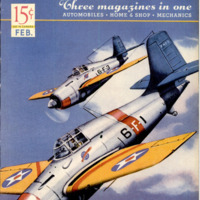 Popular Science Monthly, v. 138, n. 2, 1941
Popular Science Monthly, v. 138, n. 2, 1941

